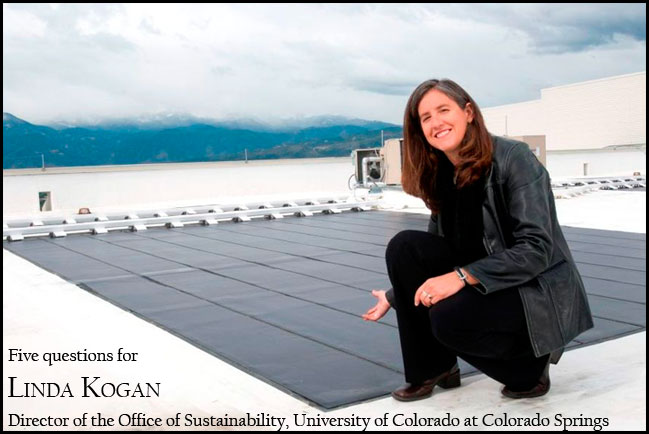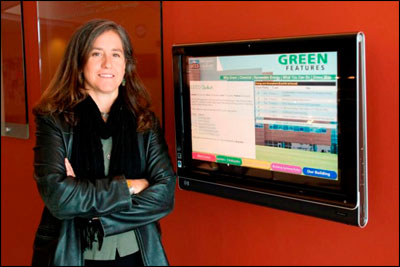
Photos courtesy of Linda Kogan |
A typical day in Linda Kogan's work week has its ups and downs. Either she's craning her neck to evaluate a building's lighting system or looking in the opposite direction while she digs through trash. Not exactly a 10 on the glamour scale the way she describes it, but then she's not interested in celebrity status; she wants to save the environment.
Kogan helped to create the Office of Sustainability at the University of Colorado at Colorado Springs four years ago, and serves as its director. She's managed a $1.3 million fund to retrofit projects for water and energy savings.

Photos courtesy of Linda Kogan |
| Like a flat screen in the Science and Engineering Building at UCCS, Linda Kogan spreads the word about green features in that and other facilities throughout the campus. |
In 2007, the sustainability office initiated a comprehensive recycling program with a goal of recycling 50 percent of the campus' trash by 2012. As a signatory to the American College and University Presidents Climate Commitment, the university must reduce emissions and develop a long-term strategy for reaching carbon neutrality. That's where Kogan comes in. She measures greenhouse gas emissions, develops conservation behavioral campaigns and pursues renewable energy projects such as solar and wind.
Through all her efforts, she's slowly changing the nonchalant, throw-away culture. Sometimes, Kogan forgets when her workday ends and can't help but stare at lights and look for recyclables at friends' houses or events around town.
It's all in the name of rescuing the planet she loves. You might find her climbing peaks for a little spring telemark skiing or heading out for long hiking journeys. A year ago, she spent nine days alone in the Weminuche Wilderness. Her only company was an "extended family of eight mountain goats."
— Cynthia Pasquale
1. What are some of the initiatives you've instituted to help the university make wise decisions about trash?
We have worked to provide sufficient recycling infrastructure. That means a recycle bin next to every trash can on campus and recycling containers in almost every room. For the past three years, we have participated in RecycleMania, a national competition among college campuses to determine who can reduce their waste and recycle the most. It is a great way to educate students about the reasons for recycling. Most people do not know that trash in a landfill creates methane, which as a greenhouse gas emitter is about 72 times more potent than carbon dioxide. We have held numerous public events to raise awareness and change behavior such as Mount Trashmore, where we brought all of one day's trash to the center of campus and went through all of it to see how much was recyclable. About 50 percent of it was. We have publicized those results and focused on the main items that could have been recycled like plastic bottles, drink cans and all forms of paper. We also started a program of having zero-waste goalies, fashioned after the CU-Boulder program, to monitor trash and ensure recycling at basketball events. We still have a long way to go to change the culture to reduce waste by actions such as bringing reusable water bottles or coffee mugs and printing only when needed.
In 2007, Gov. Bill Ritter created the Greening of State Government Executive Orders. One of the components was a goal for state agencies to strive for zero waste in both operations and construction. UCCS, as a state entity, is working toward that goal while recognizing that it won't be easy. Depending on the waste stream, about 70 percent of materials can be recycled. With industrial composting, the amount left for the landfill is less than 10 percent. UCCS currently recycles about 28 to 30 percent of our waste from operations. In construction, we have done much better with an 89 percent recycling rate for the Recreation Center, and a 94 percent recycling rate for the Science Engineering Building. We have a lot more work to do in order to push our recycling rates up. We do not have industrial composting in Colorado Springs, so we are somewhat limited. However, we have recently started a campus garden, which is coordinating with Sodexho to initiate food composting and reduce the amount of organic materials going to the landfill.
2. How much does the university spend on energy and how much has that decreased in recent years because of campus initiatives?
In 2009, energy costs for UCCS were $1.7 million. As a school that has averaged 2.3 percent full-time-equivalent student growth since 2006 and a 3 percent growth in building square footage, our utility costs have not decreased. Additionally, energy costs from the utility company have escalated each year. However, due to energy retrofits on existing buildings and the addition of three new buildings designed to LEED Gold standards with more than 30 percent increased energy efficiency above baseline buildings, we have reduced our energy use intensity per square foot by approximately 12 percent. This has provided for roughly $2.5 million of avoided utility costs for UCCS.
3. If money were no object, what would you do to push the campus to be more green?
My priority, as well as many practitioners in the sustainability arena, is to reduce greenhouse gas emissions. There are many important areas for focus, but climate disruption presents the most immediate threat to our current quality of life.
A focus on reducing emissions is a bit of a catch-all for sustainability in that it can result in significantly reduced energy, water and petroleum costs, more local and organic food, better air quality and reduced risk from potential future carbon costs. While investing in energy efficiency provides a better return than either the stock market or real estate, it still represents a significant outlay in an era when state funding is drastically shrinking. Despite our increasing energy efficiency on campus, our emissions are growing with new buildings and greater enrollment.
In order to meet our climate commitment, we will need to prioritize some funding for investment in efficiency initiatives as well as renewable energy.
I would also like to direct funds toward conservation campaigns. Many students and others on campus have no idea that buildings are the largest source of our carbon emissions. Our energy – especially in Colorado – for lighting, heating and cooling comes predominately from coal and natural gas. Because we don't have smokestacks coming from our buildings and carbon dioxide is invisible, many people think that cars are the major culprit. They are important, but people on the campus can have a big impact by shutting off lights, computers and coffeemakers when not in use, and using power strips to avoid the phantom loads of energy that are consumed even when appliances are off but plugged in.
4. What do you love about your job and what frustrates you?
What excites me most about this job is the creativity that is needed to change the culture. I never have two days that are the same. I may spend the morning presenting sustainability practices at a new staff and faculty orientation, then meet with project managers to discuss what type of low-flow, dual-flush toilet to install, then dig through trash as part of a public event to increase awareness about recycling, and finish the day with a meeting to further sustainability in the Colorado Springs community.
I am especially jazzed when I witness individuals on the campus making decisions that incorporate energy, water or waste reduction, or when an increasing number of faculty incorporate sustainability in their curriculum. Being a change agent is exciting because I always need to be out in front learning about and furthering the best sustainability practices available.
The most challenging aspect of the job is that there is so much to do – sustainability covers all aspects of the university including food, water, energy, purchasing, strategic planning, construction, waste, transportation, curriculum and more. As a small office it is impossible to accomplish all of the initiatives that feel urgent. I wish that more people felt the urgency of sustainability and viewed it not only as a responsibility, but also as potentially a tool to achieve a better quality of life.
One of the amusing aspects of my job is the reaction I sometimes get from others on the campus. People hide disposable water bottles when I come in the room, provide me with elaborate reasons why they can't walk or bike the 10 minutes to campus or confess that they just must have a personal refrigerator in their office. On the flip side, many have excitedly shared how they changed out all of the light bulbs in their house to compact fluorescent bulbs and now are saving lots of money!
5. How did you choose this career path?
In some ways it feels like my life has been leading to this particular career all along. My undergraduate work was in business and political science. I ended up doing something completely different and worked with Outward Bound for 10 years leading trips, teaching about wilderness ethics, working to instill a sense of wonder and protection of our natural resources and facilitating leadership skills and self discovery. I reconnected with my business degree by working with the Pikes Peak Sustainable Business Network to help green businesses in the region. I then completed my master's in geography and environmental studies at UCCS. My thesis focused on measuring the institutional sustainability of UCCS using the ecological footprint tool. So, even before I started this job, I was counting kilowatt hours, measuring trash and considering ways to significantly increase the sustainability of UCCS. The business degree has been very helpful in communicating the competitive advantage strategies and potential cost savings of pursuing sustainability. I feel fortunate to have chosen this field because it is growing exponentially and requires innovative thinkers to solve today's issues.
Want to suggest a faculty or staff member for Five Questions? Please e-mail Jay.Dedrick@cu.edu

|